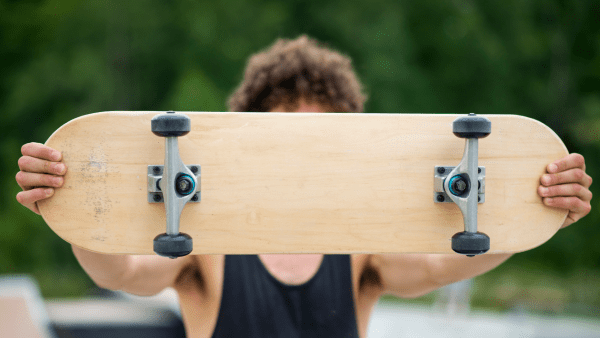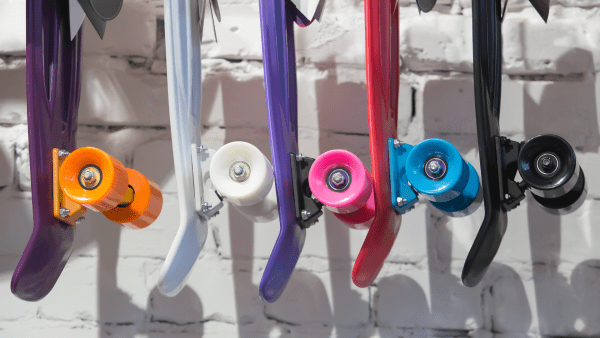Skateboarding Safety Checks and some safety tips and safety standards for staying safe.

Before hitting the pavement, it’s a good idea to take a moment to check for safety and learn some safety tips and safety standards. It’s easy to get caught up in the thrill and forget, but ensuring your skateboard is in good condition makes all the difference in your ride. Whether you’re heading to skate parks or just cruising around, wearing wrist guards, knee pads, and other protective gear like guards knee can help you stay safe and enjoy your skateboarding experience.
Don’t forget to check skateboarding safety gear, such as a fitting helmet, elbow pads, knee pads, a helmet, wrist guards, and other protective equipment. This article will walk you through the steps to see if your skateboard is safe – from inspecting the deck, examining the trucks, scrutinizing the wheels, and checking all hardware – as well as personal safety gear.
By conducting a thorough safety check and knowing adult and child safety tips on your board before each ride, you can ensure a smooth, safe, and enjoyable experience. So, let’s get started and ensure every roll is pleasant!
Key Takeaways
We’ve walked you through every essential street surfing safety assessment step and safety tips, from the deck to the hardware, ensuring that your board is in top shape and that you’re wearing the right protective gear to ride a skateboard safely. Skateboards have four main components: skateboard deck, skateboarding trucks, skateboarding wheels, and skateboarding bearings.
Regularly checking the deck for cracks, the trucks for wobbles or looseness, the wheels for flat spots or wobbles, and the bearings for rust or corrosion will help keep you and your family safe from skateboarding injuries. Street surfing safety and staying safe are not just a one-time effort but an ongoing process.
We also recommend wearing helmets, elbow and knee pads, and even wrist guards that protect the fleshy parts of your body; this is one of those safety tips. Safety should always be the top priority, but let’s not forget we’re also in this to skate and experience the thrills and fun!
We understand that street surfing is an exciting activity, but it also has its risks. That’s why learning the fundamentals of safety skateboarding and maintenance is crucial. We want to make sure that everyone is safe, so we encourage all riders to do a regular safety check of their equipment. Examining your board for any potential safety issues before you start to ride a skateboard can reduce the likelihood of an accident and enhance your overall experience. So keep checking and keep riding!

Skateboard Safety Checks
Being intimately familiar with your skateboard is essential for preventing unexpected safety issues during your ride. Grasping the intricacies of skateboards is a fundamental aspect of mastering the sport. Regular maintenance encompasses the basics like trucks, wheels, and bearings and an in-depth understanding of your skateboard as a comprehensive piece of skateboarding equipment. This guide will explore the critical steps to thoroughly inspect your deck and other components before starting your street adventures.
To start, we’ll look at the essential components of skateboards: trucks, wheels, bearings, bushings, risers, decks, and other accessories such as grip tape and wax. Additionally, to stay safe while skateboarding, wearing protective gear like a helmet, wrist guards, knee pads, and other protective equipment is crucial to minimize the risk of injury.
Check The Deck
Before we hit the road, inspecting the deck for any signs of wear and tear is crucial. You must look it over meticulously for cracks that could compromise your ride and potentially cause accidents.
Additionally, the condition of the grip tape is just as important; if it’s worn out or peeling, it won’t provide the traction needed for a safe ride. To stay safe while skateboarding, make sure to also wear protective gear like a helmet, wrist guards, knee pads, and other protective equipment to ensure maximum protection.
Inspecting Skateboard Crack
Inspecting for any signs of damage or cracks is essential, as they can have a huge impact when street surfing and even put you at risk for an injury. Cracks usually occur due to excessive force or improper use, but if you catch them quickly, you may be able to repair them and ensure your skateboards are safe. Additionally, always wear wrist guards, knee pads, and other protective gear as part of safety skateboarding to minimize the risk of injury.
Skating Board Grip Tape
Ensuring the grip tape is in good condition is essential for optimal performance and accident prevention. You must assess the grip tape’s durability and look for any wear or peeling. If it’s worn out, a tape replacement is necessary for safety.
We understand the importance of preserving our skateboarding gear and safeguarding ourselves and others. We can break this task up into more than one step. We can start with the grip tape condition. Think about the durability of it.
Inspect Trucks For Safety
When it comes to a safe and smooth skateboarding experience, inspecting the street surfing trucks is a must. Prioritize safety checking first, which is why we urge you to give your trucks a thorough once-over. Additionally, always wear wrist guards, knee pads, and other protective gear for safety skateboarding to ensure you’re well-protected while riding.
Make sure to check for looseness or wobbles, as truck tightness is essential for a successful ride. If you spot any wear or damage, don’t hesitate to replace them. Regularly inspecting your skateboard is a good idea, especially if you frequent skate parks. Additionally, always wear protective gear like wrist guards, knee pads, and elbow pads to ensure safety. Don’t forget your guard’s knee to prevent injuries during your ride.
After examining the trucks, it’s time to move on to the next essential checkpoint: assessing the integrity of the wheels. Remember, always wear a helmet, wrist guards, knee pads, and other necessary safety gear for maximum protection.
Examine Skateboard Wheels
Now that we’ve tackled inspecting the trucks, let’s check the wheels.

It’s crucial to check both the condition and size of your wheels, as these factors significantly affect how well your skateboard performs and skateboarding safety tips. Also, don’t forget to check the bearings since they’re responsible for ensuring smooth wheel rotation; poor or damaged bearings can greatly affect your ride.
Skateboarding Wheels
Don’t overlook the condition and size of the wheels, as they play a vital role in a safe and smooth ride. Inspecting the wheel material is important, as different materials are suited to different ride terrains. When picking wheels, make sure they match your skating style and terrain preferences.
Their size is equally important – larger wheels offer more speed, while smaller ones provide better maneuverability. Before you hit the streets, don’t forget to check the bearings, another key factor to inspect as part of the skateboarding safety tips.
Bearings
Checking the bearings is essential to keeping your ride smooth and efficient. We want to ensure you have all of the information you need to ensure your bearings are in great condition. Here’s what you need to do:
- Check for any visible signs of wear or tear on the skateboard.
- Test the rotation of the skateboard bearings; they should spin freely.
- Make sure the skateboard bearings have the right lubricant applied.
- Plan for skateboard bearing replacement if necessary.
Remember, well-maintained bearings can help you stay safe on skateboards!
Let’s ensure your hardware is secure and ready to go.
Inspect Skateboard’s Hardware
Before hitting the pavement, it’s essential to check the condition of your skateboard’s hardware. Safety starts with proper maintenance, so we always recommend checking skateboard materials and bolt tightness to ensure a smooth street surfing experience and other safety tips.
Make sure to tighten bolts just enough to secure wheels and trucks, but be careful not to over-tighten and risk damaging parts. To ensure the best possible ride, it’s important to consider safety gear, such as a multi-sport helmet, knee and elbow pads, and other accessories.
You can find a variety of skateboard types, including longboards, minis, streetboards, and cruisers. You can also find a variety of skateboard hardware to choose from, including skateboard decks, skateboarding trucks, skateboarding wheels, and skateboard bearings.
We recommend researching the various types of hardware and components to find the perfect combination for your individual needs. It’s a good idea to tailor your setup, such as skate parks, based on where you’ll be skating. Additionally, for safety, always wear a helmet, wrist guards, knee pads, and other safety accessories, and don’t forget your knee guards (it guards knee) to protect yourself from injuries.
Skateboarding Safety Gear To Avoid Serious Injury
Skateboarding is a popular pastime for many people, and it’s important to prioritize safety while enjoying it, as this is one of the skateboarding safety tips. We understand the significance of equipping yourself with the right personal safety gear. This includes a helmet, knee pads, and wrist guards.
A helmet is crucial for protecting your head from any potential accidents. Parents should ensure their kids are always wearing one, whether they are riding at home or in parks. It’s also important to find the right knee and elbow pads to minimize injuries, as they lessen the impact on your knees and elbows when you fall. Practice sessions are a great way for a child to get used to their gear, and wrist guards shield their wrists during spills. Always seek out tips from experienced riders to keep safe.
These essential safety equipment, such as knee and elbow pads, should never be neglected when hitting the streets on your skateboard! Following these skateboarding safety tips will help you stay safe while skateboarding and prevent unnecessary injuries.
Conclusion
We’ve walked you through every essential skateboarding safety inspection, from the deck to the hardware, making sure that your board is in top shape and that you’re wearing the right safety gear, as this is one of the most important skateboarding safety tips.
To further ensure you and your family stay safe, this article recommends checking out street surfing helmets, elbow and knee pads, and even wrist guards and other safety gear. It’s not just about safety; we’re in this for the thrills and fun, too!
So, keep checking and keep riding! Safety skateboarding means always wearing your helmet, wrist pads, and elbow pads to protect yourself from injuries.
Frequently Asked Questions
How Can You Be Safe On A Skateboard?
Safety is crucial. To ensure street surfing safety, here are some safety tips: always wear a helmet, preferably a properly fitting or multi-sport helmet. Also, wear wrist guards, knee pads, elbow pads, and other essential safety equipment. Stick to smooth pavement and avoid wet weather to prevent serious injury like a head injury. Staying safe while skateboarding should always be your top priority.
Can I Bring A Skateboard On An Airplane?
Yes, you can bring a skateboard on an airplane. However, it’s crucial to adhere to the airline’s safety check standards for safety reasons. It’s advisable to discuss this with the airline in advance, especially when traveling with more than one person carrying skateboard.
How Do You Bring A Skateboard On A Plane?
To bring a skateboard on a plane while guaranteeing its safety, wrap it securely to protect it from other debris. Follow the Consumer Product Safety Commission guidelines, and ensure it doesn’t obstruct the path of other skateboarders or luggage in the cargo.
How Do You Know If A Skateboard Is Good?
A good skateboard should have smooth, well-fitted parts, like the deck and wheels. Inspect for irregular surfaces and ensure they can handle traffic from inline skates and other similar activities. Always use protective gear like pads and elbow pads for safety skateboarding to prevent injuries and ensure a smooth, enjoyable ride.
What Is The Most Common Injury In Skateboarding?
The most common injury in street surfing is a head injury. This is why it’s essential to wear a helmet and use protective gear to protect the fleshy parts of your body. Many people, including children and skateboarders, participate in this activity, so it’s crucial to be properly prepared. Maintaining your balance can help prevent falls, and knowing how to roll when you do fall can minimize injuries. Whether you’re a child or an adult, always stay clear of the car traffic while street surfing to ensure your safety.
How Do Wrist Guards Contribute To Injury Prevention?
Wrist guards play a crucial role in injury prevention during street surfing accidents. In skate parks, where skaters may lose control, these guards provide essential safety by reducing the impact on the wrists when falling on the often soft surfaces. When combined with skateboard helmets, wrist guards offer comprehensive safety check measures to minimize the risk of injuries.
Are There Skateboard Injuries Involve The Use Of Elbow Pads?
Skateboarding injuries can vary based on factors such as skill level, the presence of motor vehicles, and the type of surfaces involved. Beginners might face challenges on uneven surfaces, increasing the likelihood of accidents.
What Not To Do When Skateboarding?
Avoid street surfing near moving vehicles or in areas with high traffic. It’s also vital not to skate on wet surfaces or without adult supervision for children.
Is It OK For A Girl To Skateboard?
Absolutely, skateboarding is for everyone. Both girls and boys should, however, follow street surfing safety guidelines and safety tips and wear essential safety equipment at the skate park or anywhere else.
What Are The Long-Term Effects Of Skateboarding?
Long-term street surfing without proper safety gear can lead to chronic injuries in various parts of the body. However, with consistent safety check measures, the sport offers great physical benefits and enhances body coordination. But remember, check safety first!
